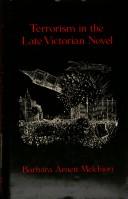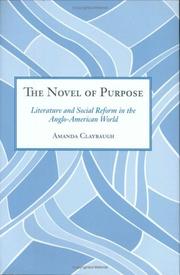| Listing 1 - 10 of 10 |
Sort by
|
Periodical
Abstract | Keywords | Export | Availability | Bookmark
 Loading...
Loading...Choose an application
- Reference Manager
- EndNote
- RefWorks (Direct export to RefWorks)
Literature --- Social movements --- Social movements in literature --- Movements, Social --- Social history --- Social psychology --- Literature. --- Social movements. --- Social movements in literature.
Book
ISBN: 9780824833657 Year: 2009 Publisher: Honolulu University of Hawai'i press
Abstract | Keywords | Export | Availability | Bookmark
 Loading...
Loading...Choose an application
- Reference Manager
- EndNote
- RefWorks (Direct export to RefWorks)
Book
ISBN: 0253029880 9780253029553 0253029554 9780253029881 0253029554 9780253029843 0253029848 Year: 2017 Publisher: Bloomington
Abstract | Keywords | Export | Availability | Bookmark
 Loading...
Loading...Choose an application
- Reference Manager
- EndNote
- RefWorks (Direct export to RefWorks)
Through manifestos, fundraising tracts, novels, letters, and pamphlets, they piece together the intellectual world where philanthropists reasoned through their efforts and redefined the public sector.

ISBN: 0709935838 Year: 1985 Publisher: London : Croom Helm,
Abstract | Keywords | Export | Availability | Bookmark
 Loading...
Loading...Choose an application
- Reference Manager
- EndNote
- RefWorks (Direct export to RefWorks)
English fiction --- Radicalism in literature. --- Social movements in literature. --- Social problems in literature. --- Terrorism in literature. --- Terrorism --- History and criticism --- History

ISBN: 0816637709 0816637717 Year: 2005 Publisher: Minneapolis (Minn.) : University of Minnesota press,
Abstract | Keywords | Export | Availability | Bookmark
 Loading...
Loading...Choose an application
- Reference Manager
- EndNote
- RefWorks (Direct export to RefWorks)
Protest movements --- Radicalism in art. --- Radicalism in literature. --- Radicalism --- Social movements in art. --- Social movements in literature. --- History and criticism --- Songs and music --- History and criticism.

ISBN: 150172701X 9781501727016 0801444802 9780801444807 Year: 2007 Publisher: Ithaca Cornell university press
Abstract | Keywords | Export | Availability | Bookmark
 Loading...
Loading...Choose an application
- Reference Manager
- EndNote
- RefWorks (Direct export to RefWorks)
In the nineteenth century, Great Britain and the United States shared a single literary marketplace that linked the reform movements, as well as the literatures, of the two nations. The writings of transatlantic reformers-antislavery, temperance, and suffrage activists-gave novelists a new sense of purpose and prompted them to invent new literary forms. The result was a distinctively Anglo-American realism, in which novelists, conceiving of themselves as reformers, sought to act upon their readers-and, through their readers, the world. Indeed, reform became so predominant that many novelists borrowed from reformist writings even though they were skeptical of reform itself. Among them are some of the century's most important authors: Anne Brontë, Charles Dickens, George Eliot, Thomas Hardy, Henry James, Elizabeth Stoddard, and Mark Twain. The Novel of Purpose proposes a new way of understanding social reform in Great Britain and the United States. Amanda Claybaugh offers readings that connect reformist agitation to the formal features of literary works and argues for a method of transatlantic study that attends not only to nations, but also to the many groups that collaborate across national boundaries.
Literature and society --- Social movements in literature. --- Social problems in literature. --- American fiction --- English fiction --- History --- History and criticism. --- Social movements in literature --- Social problems in literature --- 820 "18" --- 82:3 --- 820 "18" Engelse literatuur--19e eeuw. Periode 1800-1899 --- Engelse literatuur--19e eeuw. Periode 1800-1899 --- History and criticism --- Literatuur en maatschappijwetenschappen --- 82:3 Literatuur en maatschappijwetenschappen
Book
ISBN: 161277511X Year: 2009 Publisher: Kent, Ohio : Kent State University Press,
Abstract | Keywords | Export | Availability | Bookmark
 Loading...
Loading...Choose an application
- Reference Manager
- EndNote
- RefWorks (Direct export to RefWorks)
Social movements in literature. --- Social movements in art. --- Arts and society --- Bohemianism --- History --- New York (N.Y.) --- New York (N.Y.) --- New York (N.Y.) --- Social conditions --- Intellectual life --- History
Book
ISBN: 1283009250 9786613009258 904202982X 9042029811 9789042029828 9789042029811 9781283009256 6613009253 Year: 2011 Publisher: Amsterdam New York, NY
Abstract | Keywords | Export | Availability | Bookmark
 Loading...
Loading...Choose an application
- Reference Manager
- EndNote
- RefWorks (Direct export to RefWorks)
"This volume addresses contemporary activist practices that aim to interrupt and reorient politics as well as culture. The specific tactics analyzed here are diverse, ranging from culture jamming, sousveillance, media hoaxing, adbusting, subvertising, street art, to hacktivism, billboard liberation, and urban guerilla, to name but a few. Though indebted to the artistic and political movements of the past, this form of activism brings a novel dimension to public protest with its insistence on humor, playfulness, and confusion. This book attempts to grasp both the old and new aspects of contemporary activist practices, as well as their common characteristics and internal varieties. It attempts to open up space for the acknowledgement of the ways in which contemporary capitalism affects all our lives, and for the reflection on possible modes of struggling with it. It focuses on the possibilities that different activist tactics enable, the ways in which those may be innovative or destructive, as well as on their complications and dilemmas. The encounter between the insights of political, social and critical theory on the one hand and activist visions and struggles on the other is urgent and appealing. The essays collected here all explore such a confrontational collaboration, testing its limits and productiveness, in theory as well as in practice. In a mutually beneficial relationship, theoretical concepts are rethought through activist practices, while those activist practices are developed with the help of the insights of critical theory. This volume brings scholars and activists together in the hope of establishing a productive dialogue between the theorizations of the intricacies of our times and the subversive practices that deal with them." --Publisher's website.
Protest movements. --- Social movements in art. --- Social movements in literature. --- Protest movements --- Social change --- Art --- Politics and culture --- Sociology & Social History --- Social Sciences --- Social Conditions --- Political aspects --- Social change. --- Politics and culture. --- Culture --- Culture and politics --- Change, Social --- Cultural change --- Cultural transformation --- Societal change --- Socio-cultural change --- Social history --- Social evolution --- Political aspects. --- Social movements --- Art and politics --- Politics and art
Book
ISBN: 1612775101 Year: 2009 Publisher: Kent, Ohio : The Kent State University Press,
Abstract | Keywords | Export | Availability | Bookmark
 Loading...
Loading...Choose an application
- Reference Manager
- EndNote
- RefWorks (Direct export to RefWorks)
Cultural politics and American bohemians in preCivil War New York Amid the social and political tensions plaguing the United States in the years leading up to the Civil War, the North experienced a boom of cultural activity. Young transient writers, artists, and musicians settled in northern cities in pursuit of fame and fortune. Calling themselves bohemians after the misidentified homeland of the Roma immigrants to France, they established a coffeehouse society to share their thoughts and creative visions. Popularized by the press, bohemians became known for romantic, unorthodox notions of literature and the arts that transformed nineteenthcentury artistic culture. Bohemian influence reached well beyond the arts, however. Building on midcentury abolitionist, socialist, and free labor sentiments, bohemians also flirted with political radicalism and social revolution. Advocating free love, free men, and free labor, bohemian ideas had a profound effect on the debate that raged among the splintered political factions in the North, including the fledgling Republican Party from which President Lincoln was ultimately elected in 1860. Focusing on the overlapping nature of culture and politics, historian Mark A. Lause delves into the world of antebellum bohemians and the newspapermen who surrounded them, including Ada Clare, Henry Clapp, and Charles Pfaff, and explores the origins and influence of bohemianism in 1850s New York. Against the backdrop of the looming Civil War, The Antebellum Crisis and Americas First Bohemians combines solid research with engaging storytelling to offer readers new insights into the forces that shaped events in the prewar years.
Bohemianism --- Arts and society --- Social movements in art. --- Social movements in literature. --- History --- History --- New York (N.Y.) --- New York (N.Y.) --- New York (N.Y.) --- History --- Intellectual life --- Social conditions --- Arts And Society --- New York (N.Y.) --- Art --- History --- Social Science
Book
ISBN: 9783034307253 303430725X Year: 2012 Publisher: Bern New York : Peter Lang,
Abstract | Keywords | Export | Availability | Bookmark
 Loading...
Loading...Choose an application
- Reference Manager
- EndNote
- RefWorks (Direct export to RefWorks)
Utopias in literature. --- Social problems in literature. --- Social movements in literature. --- Science fiction --- Utopias --- Socialism --- Literature and society --- Utopies --- Science-fiction --- Bellamy, Edward, 1850-1898. Looking backward --- Wilde, Oscar, 1854-1900. Soul of man under socialism --- Wells, H. G (Herbert George), 1866-1946. Time machine --- Bellamy, Edward (1850-1898). Looking backward --- Social aspects. --- Philosophy. --- History. --- Dans la littérature --- Aspect social --- Bellamy, Edward, --- Wilde, Oscar, --- Wells, H. G. --- Dans la littérature
| Listing 1 - 10 of 10 |
Sort by
|

 Search
Search Feedback
Feedback About UniCat
About UniCat  Help
Help News
News